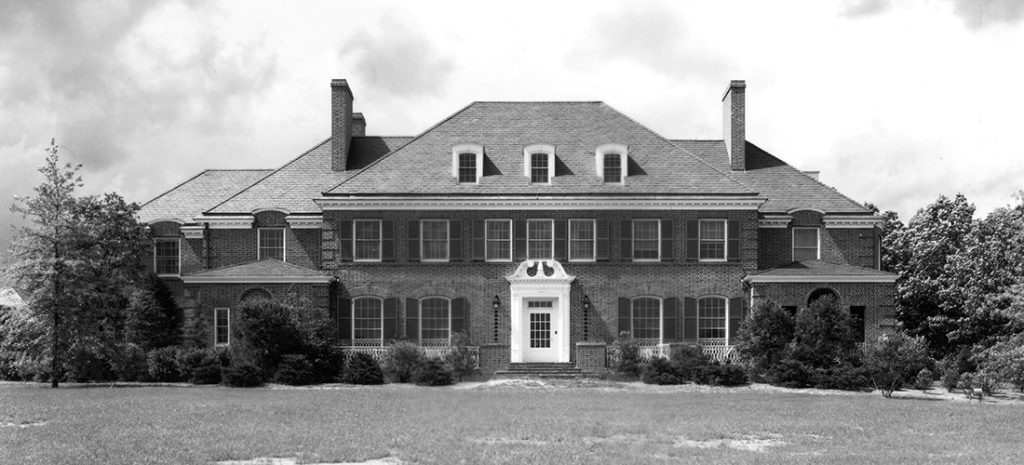
J. Spencer Love’s storied Irving Park mansion faces a new era
By Ross Howell Jr. • Photographs by Amy Freeman
Feature image: Photograph © Greensboro History Museum Collection
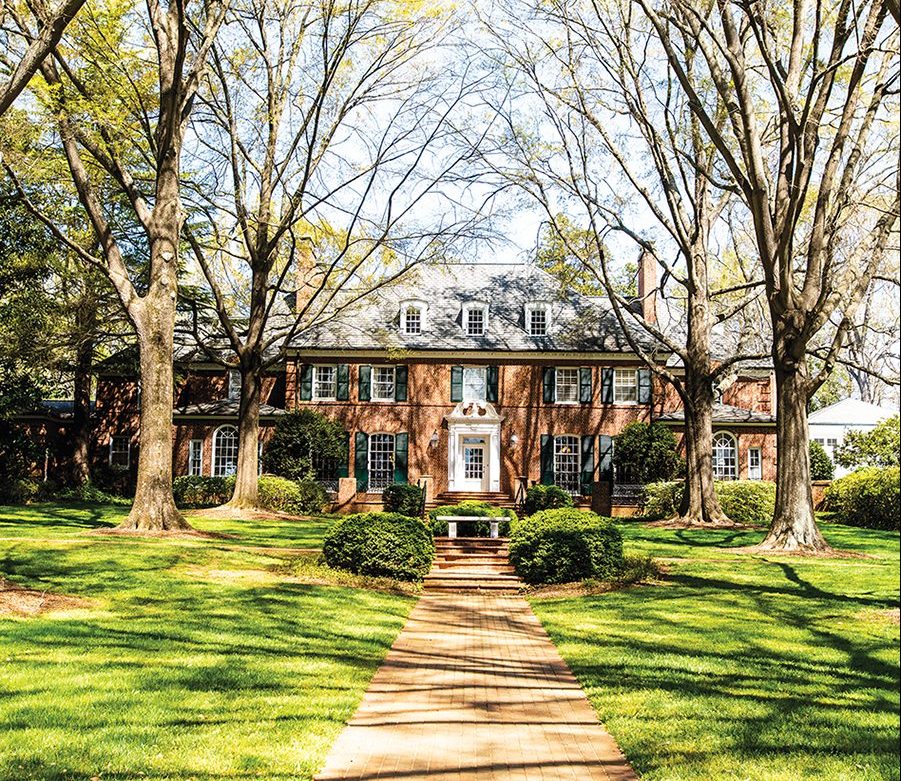
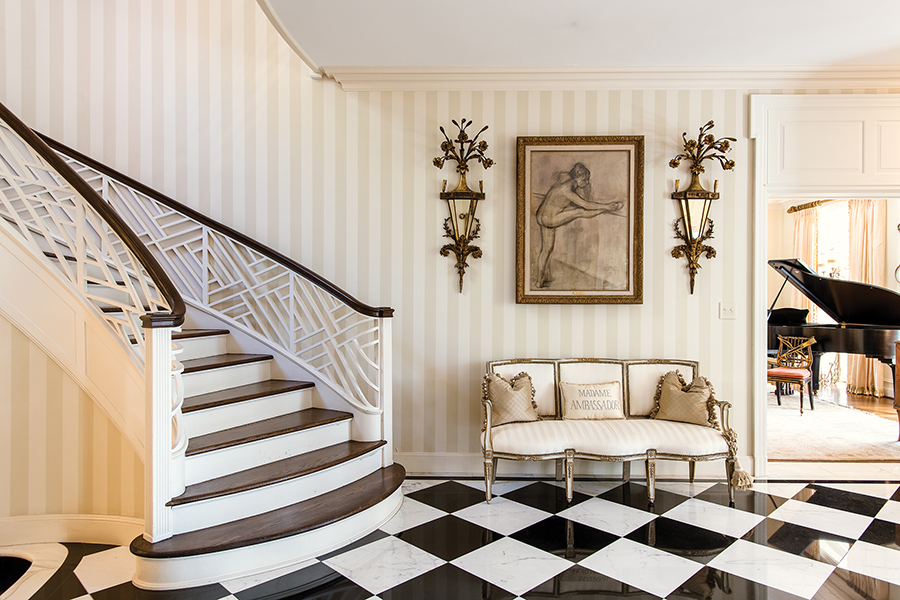
In 1936, when J. Spencer Love sat down in his company’s Greensboro headquarters to review local architect William C. Holleyman Jr.’s drawings for a new house, he saw a Georgian Revival masterpiece, a mansion that reflected the majesty of Westover, the plantation residence of William Byrd II of Virginia. Built in 1730, Westover is considered to be one of the finest examples of Georgian architecture in America.
Greensboro had never seen such a house and probably never will again. Its history can’t be repeated. Its craftsmanship can’t be replicated.
When writer Meredith Barkley asked current owner Bonnie McElveen-Hunter back in 1997 why she bought the Love house, she responded, “I cannot tell.”
She reflected a moment, then continued.
“There’s no rational reason why you would buy a house like this. It’s totally emotional, irrational,” McElveen-Hunter said.
One chilly morning this spring, Benjamin Briggs, executive director of Preservation Greensboro, along with Katie Redhead and Gail Casper, took me on a grand tour of Love and Holleyman’s showpiece.
Briggs and I are standing on the stately brick walkway lined with oak trees and boxwood plantings that leads to the front entrance of the Love house.
Briggs tells me back in the day, guests would have probably been let off at Country Club Drive, so they would sense the expanse and balance of the house as they made their way up the walk — as we’re doing now.
He explains the language of Georgian architecture, its symmetry and balance, points out the wide, Palladian floor-to-ceiling windows of the first floor, the use of quoins at the corners of the house, the modillions — ornate brackets at the eaves supporting the roof.
The brick work, Briggs tells me, is “Flemish bond,” where the bricks alternate between end (header) and length (stretcher), short and long — like Morse code.
The entrance itself is classic Georgian.
“The frontispiece around the door is called a broken pediment,” Briggs says. He points to shapes above the door that look almost like scrolls.
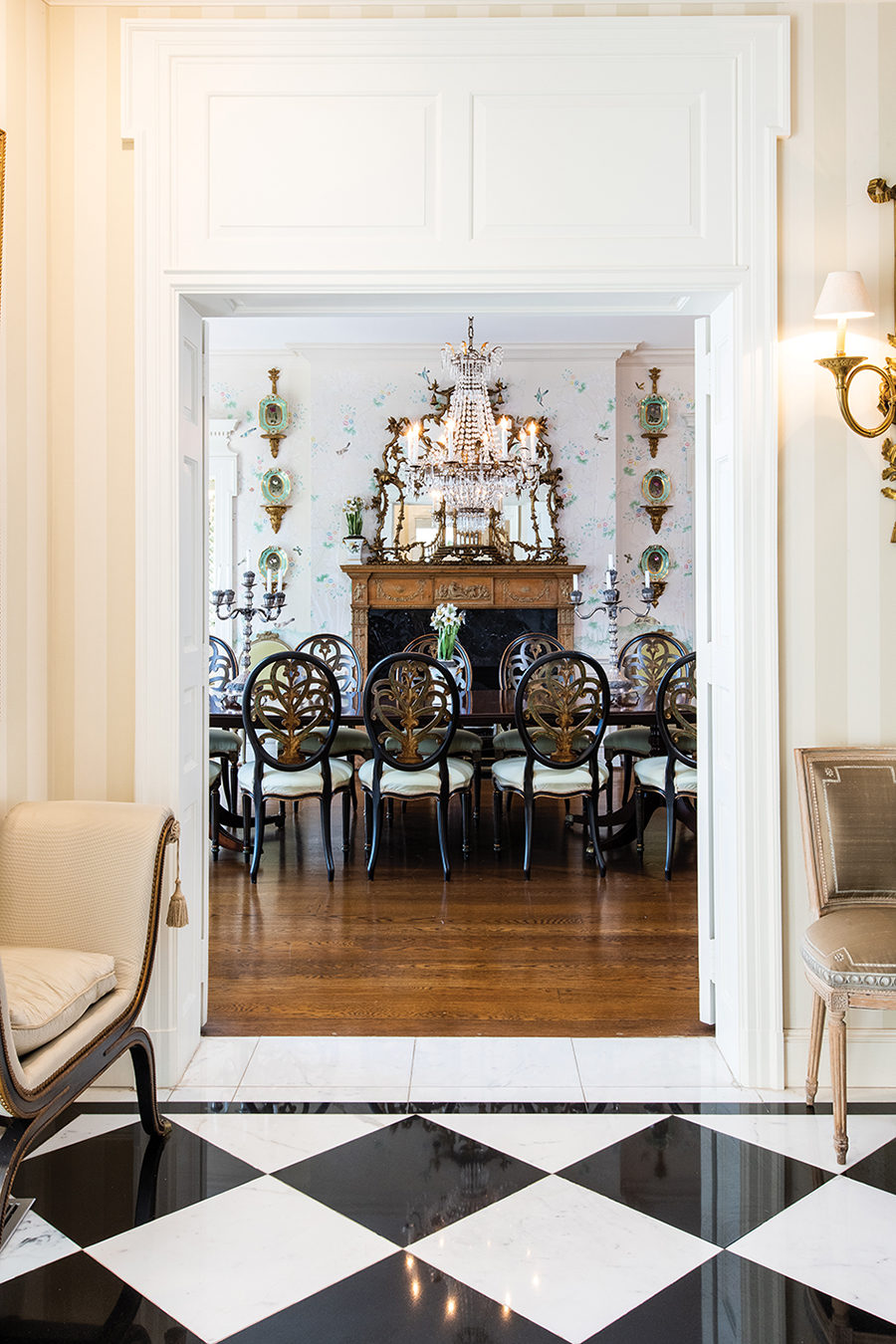
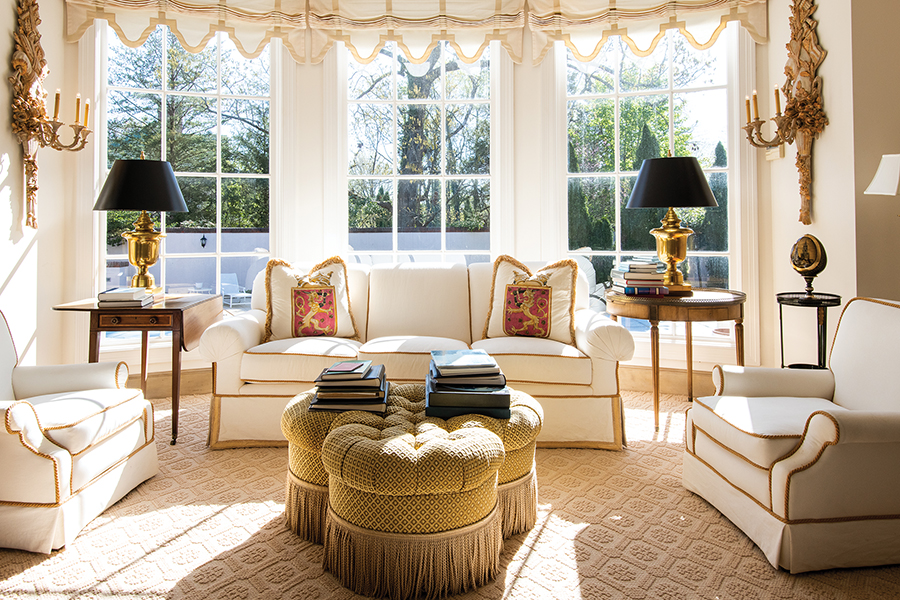
“That’s called a swan neck,” he continues. “The pineapple at the center is a symbol of welcome.”
The pilasters on either side of the door are topped with Ionic capitals — again, typically Georgian.
But Briggs notes anomalies in the elliptical design of the metal railings of the walkways and grills protecting the windows.
“Otto Zenke,” he says.
Zenke was a legendary interior designer who came to Greens-boro in 1937, when Love was building his house.
Born in Brooklyn in 1909, Zenke was employed at B. Altman & Co. in New York before accepting a position as chief decorator for Morrison-Neese Furniture Company in Greensboro. In time he would establish his own design studio, with offices here and in London and Palm Beach.
(Handmade, miniature-scale rooms crafted by Zenke that reflect his passion for late 18th-century English interiors are part of the permanent collection of the Greensboro History Museum.) Zenke was the designer of choice for numerous homes and buildings during his career.
Stepping through the front door, Briggs and I are met with a grand foyer, its marble floor set with alternating black-and-white tiles. At the far end of the foyer is a sweeping, elegantly curved staircase with Chippendale railings.
“More Zenke,” Briggs says. “There’s ceremony as you enter and drama at the stairs, where the lady of the house would make her entrance for a party.”
“Bonnie really opened this house up to people,” Redhead tells us. She recalls Christmas celebrations when McElveen-Hunter would invite carolers to come in and all would sing carols together in the foyer.
“She held an evening charity event for Habitat for Humanity of Greater Greensboro,” Casper says. “She raised $1 million in one night. Can you imagine?”
In addition to entertaining neighbors, friends and business associates, and accommodating fundraising events for a panoply of nonprofit and charitable organizations, McElveen-Hunter provided lodgings for a number of national political leaders.
“Vice President Dan Quayle, Secretary of State Henry Kissinger, President George W. Bush, Justice Sandra Day O’Connor, Secretary of State Colin Powell . . . ,” Redhead recollects.
“And a number of governors and candidates,” she adds.
We walk to the elegant stairway to take a closer look. The skill of the handwork in the curved Chippendale railings is humbling.
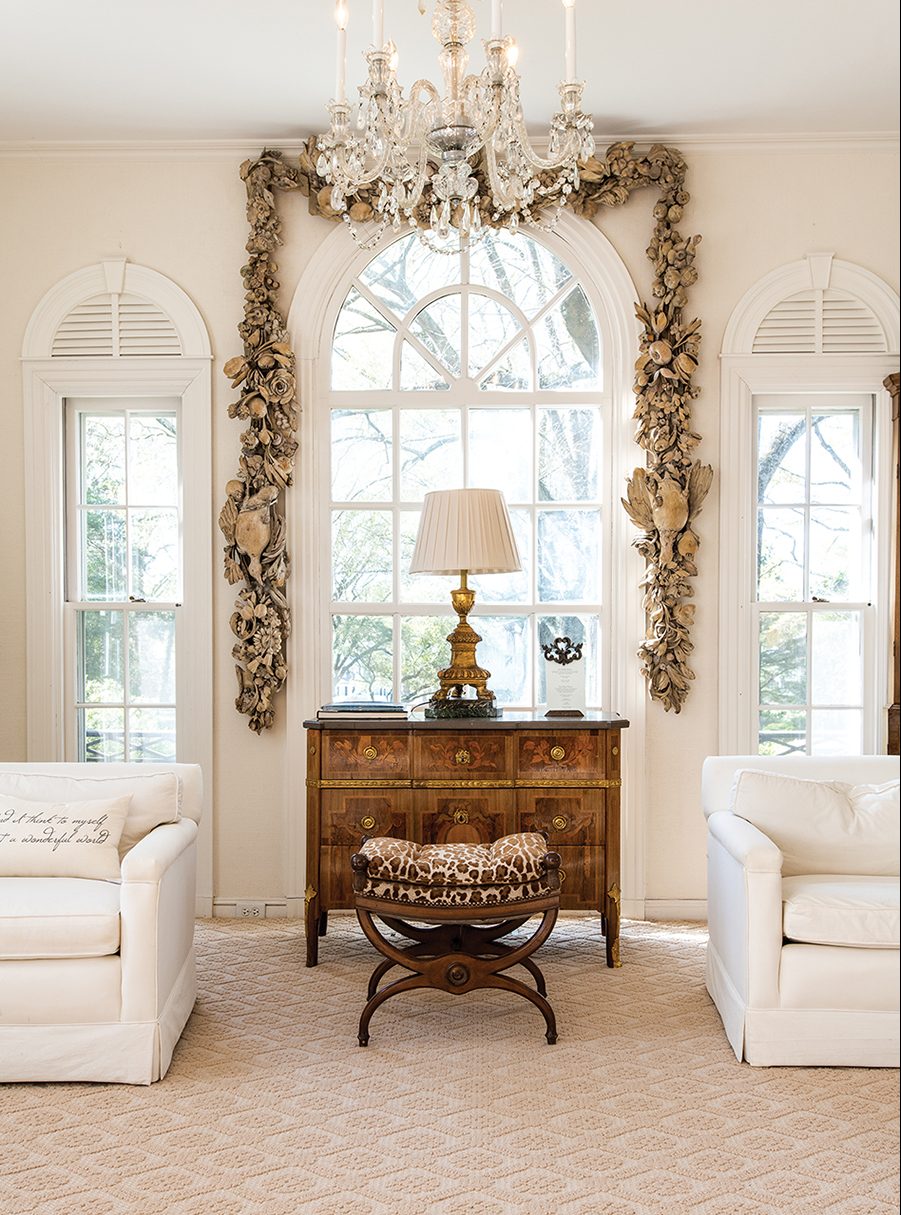
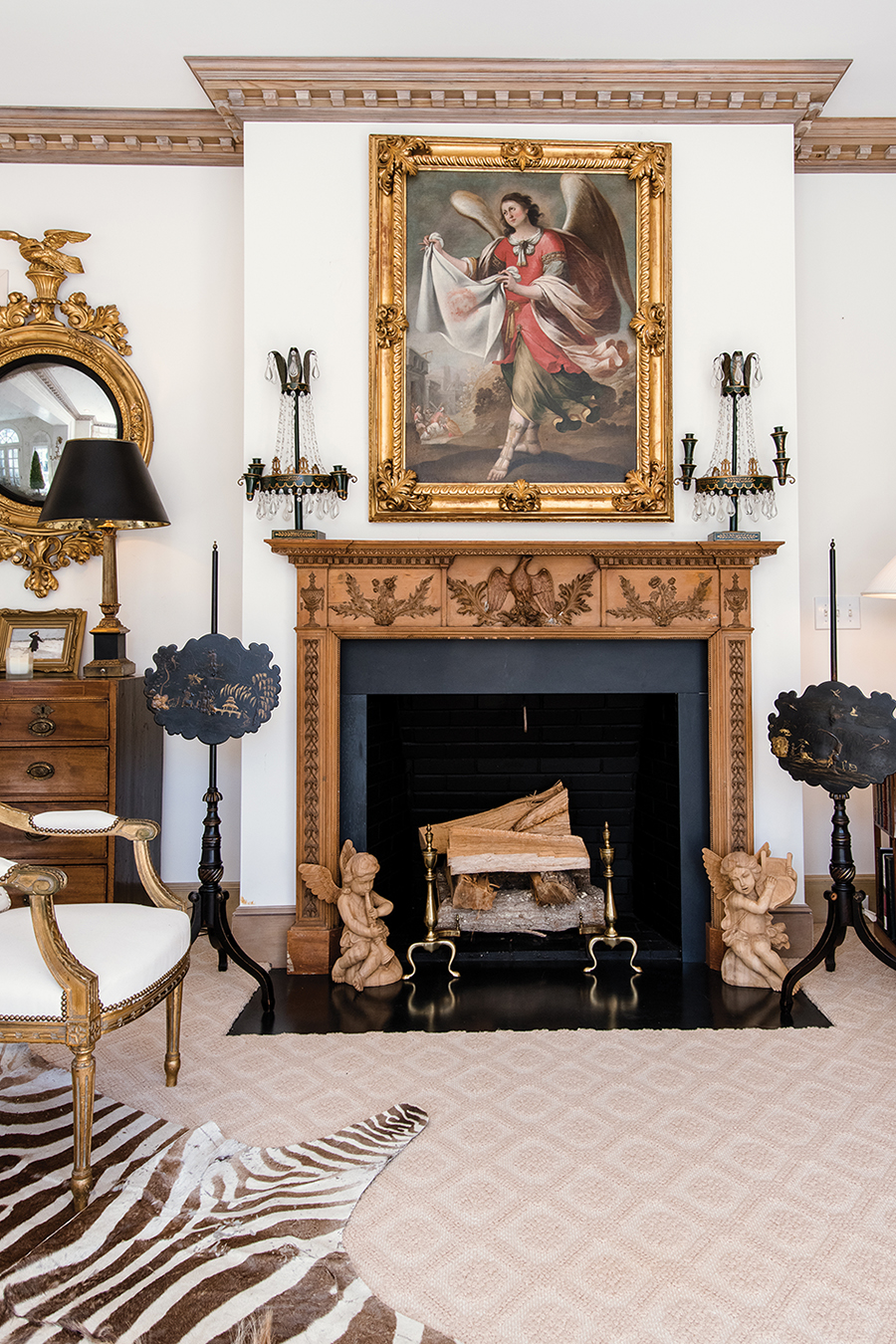
“Lord help the carpenters who installed this,” Briggs says. “It’s like a jigsaw puzzle.”
The rest of my tour is like this. We visit the stately, light-filled living room; the Cone room — where former owner Anne Cone especially enjoyed entertaining her friends. We admire the handsome, mahogany-paneled library with its curved wooden doors; and the latticed breakfast room.
Then we journey outside to see three other buildings that were renovated or added by various owners over the years. A pool house — redolent with Palm Beach charm and an elegantly landscaped pool; the carriage house — a three-bay garage renovated into living quarters; and just beyond the tennis courts, a two-story cottage with the ambiance of a European hunting lodge — formerly the greasy garage where fourth owner Rusty Taylor kept his RV parked.
And there are the more than three acres of gardens and grounds, private and woodsy, right in the heart of Irving Park.
Spencer Love built his house at a time when many Americans were struggling just to make ends meet. After the 1929 stock market crash, America had plummeted into the Great Depression. Unemployment and despair worsened in 1934, when drought forced struggling Midwestern farm families from their homesteads into nomadic Dust Bowl work camps.
Meanwhile, “Greensboro’s textile industry emerged essentially unscathed from the Depression,” writes architectural historian Marvin A. Brown. And that is a fact woven intricately into the fabric of our city’s history.
So why shouldn’t the wealthy president of Burlington Mills be planning a grand house to be built on a knoll overlooking the Greensboro Country Club golf course?
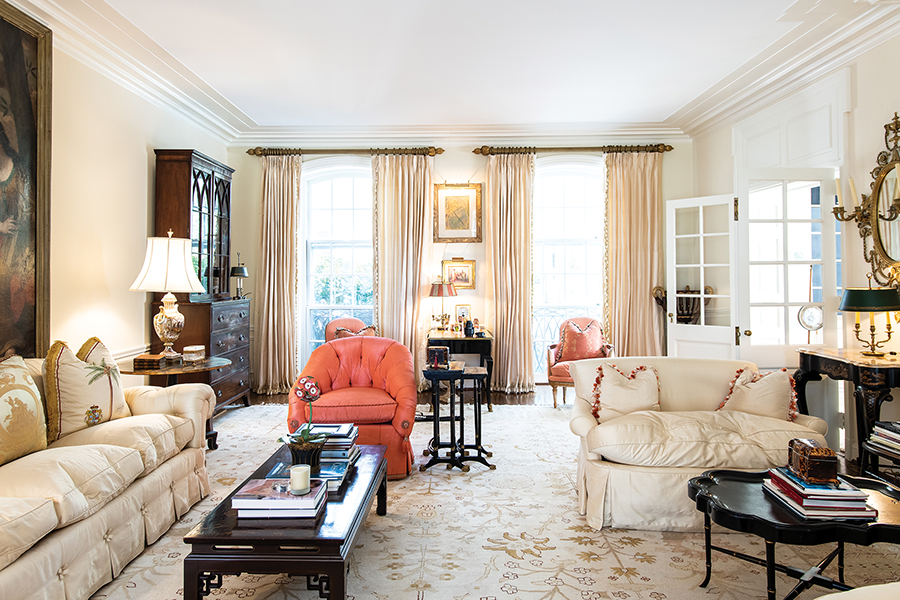
Word about construction of Love’s house appeared in an April 1936 article in the Greensboro Daily News under the headline, “New Home for President of Burlington Mills Company to Be One of Finest in City.”
Work on the foundations had already commenced. The reporter proclaimed that the “new residence will be of the colonial type, constructed of red brick. It will be a 10-room, two-story structure, modern in every respect.” It’s said that the house featured the first central air-conditioning in North Carolina — a system of forced air flowing over coils that circulated water.
Born in Cambridge, Massachusetts, where his father was professor of mathematics at the Lawrence Scientific School of Harvard University, Love studied at Harvard Business School before enlisting with the U.S. Army during World War I.
In 1919, Love returned to Boston, looking for work. Deciding better opportunities might lie elsewhere, he moved to Gastonia, where his paternal grandfather had been a pioneer in the textile industry.
With borrowed money, Love purchased the Gastonia Cotton Manufacturing Company. Eventually he sold the company’s building and land, and — after receiving financial assistance from the local chamber of commerce — moved his manufacturing equipment to Burlington.
In 1923, Love chartered a new company, aptly named Burlington Mills.
Built in the middle of a cornfield, the facility employed 200 people and manufactured all-cotton textiles, including flag cloth, bunting, scrims, curtain and dress fabrics, as well as cloth for diapers.
Then Love decided to experiment with a new synthetic fiber called rayon and began to manufacture bedspreads.
By 1936, Love had moved his company’s headquarters from Burlington to downtown Greensboro.
By then, Burlington Mills, the business he’d chartered in 1923, comprised 22 manufacturing facilities located in nine different communities. Annual sales had reached $25 million. Lawyers and accountants were preparing documents for the company to be listed on the New York Stock Exchange.
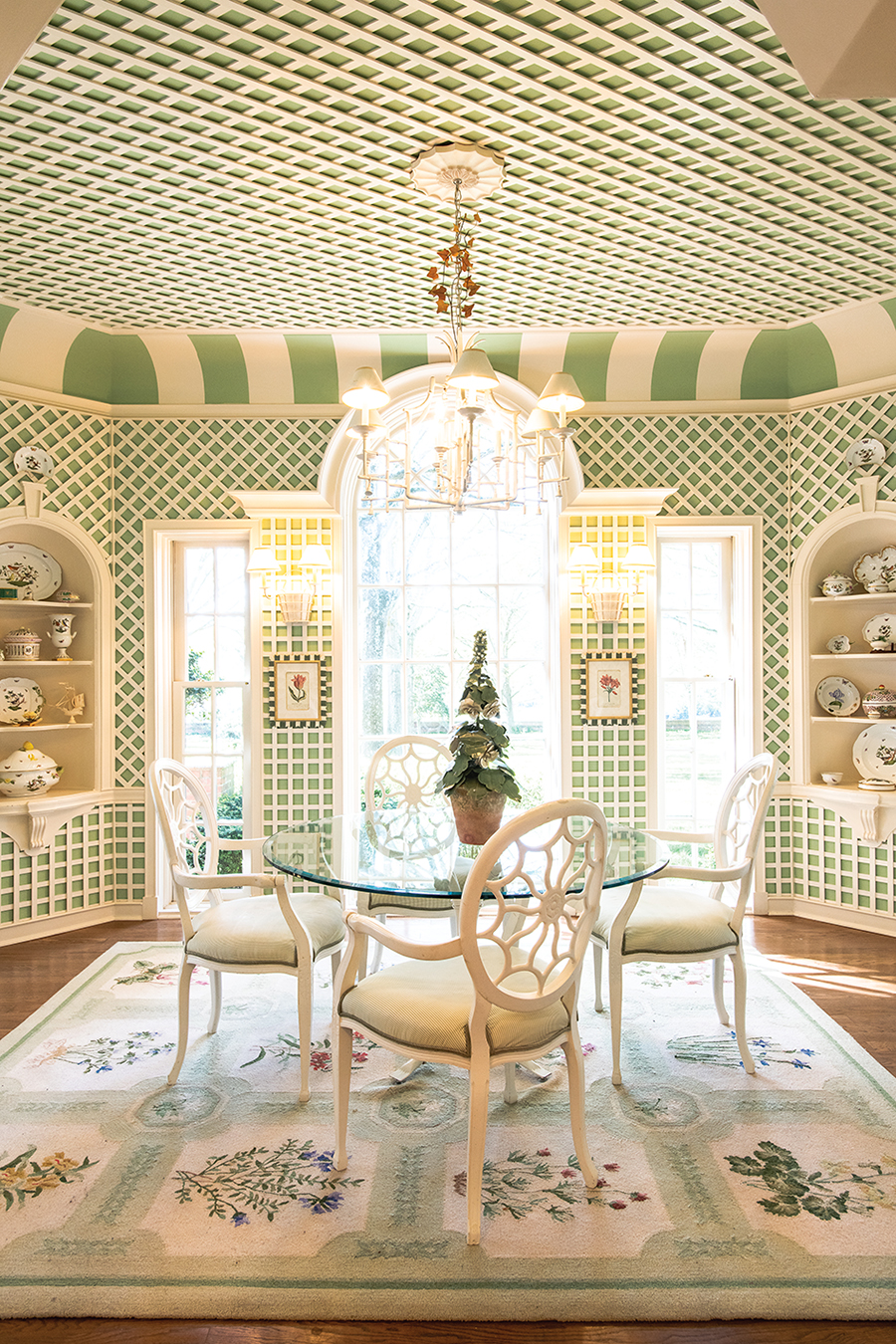
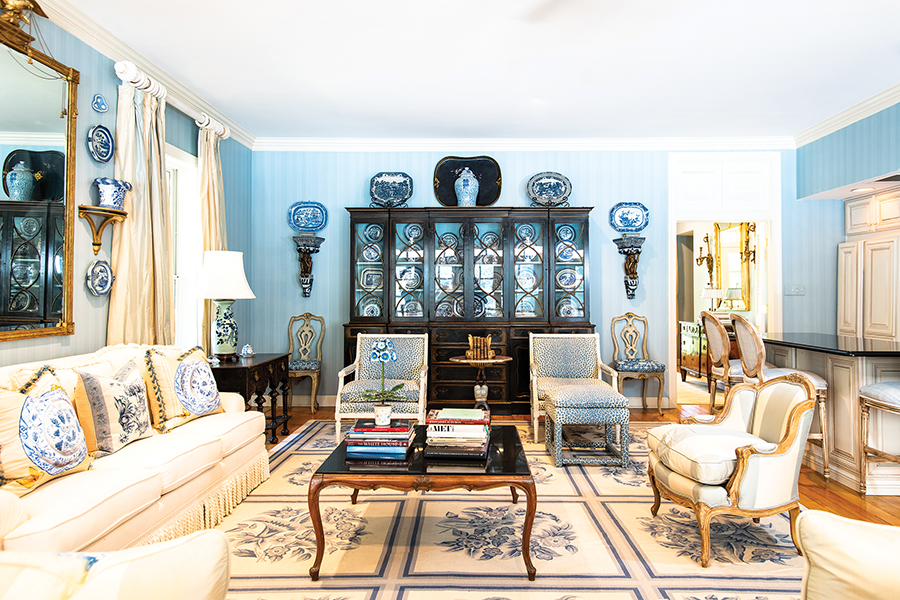
Some said that as a native New Englander, Love saw himself as an “outsider.”
Briggs believes Love was building his house to make a statement.
“He’s building a grand house overlooking the golf course in the midst of the Depression,” says Briggs. “He was staking a claim.”
For his architect, Love had chosen an individual who was somewhat of an outsider, too.
“Holleyman was not the obvious choice to be the architect for such a house,” Briggs says. “By contrast, someone like Charles Hartmann was well-known to the community,” Briggs adds. Architect Hartmann had been recruited from New York by financier Julian Price to design the Jefferson Standard Building and had designed many imposing structures and residences in Greensboro, including Price’s landmark home.
In contrast, when Holleyman arrived in Greensboro in 1922, he was still in his 20s and relatively inexperienced. A native of Atlanta, he had studied at the Georgia Institute of Technology before moving to New York, where he worked as an architect for two years.
Young Holleyman was winning contracts in Greensboro, designing not only homes here and in Pinehurst, but also larger structures for Woman’s College (UNC-Greensboro) and A. and T. (North Carolina A&T State University).
And it was Holleyman whom Love had chosen to design his new Burlington Mills headquarters in Greensboro.
Sadly, Holleyman’s enjoyment of his professional triumph was cut short.
In 1939, the Greensboro Daily News announced funeral services “for William Crumley Holleyman Jr., 45, prominent Greensboro architect who died shortly before noon yesterday of a heart attack.”
Also short-lived was Spencer Love’s enjoyment of his magnificent new home.
He was forced to give up the house in his 1940 divorce settlement with his first wife, Sarah Elizabeth, who remained there for a short while before moving to Connecticut.
The house was then purchased by Love’s friend, Benjamin Cone.
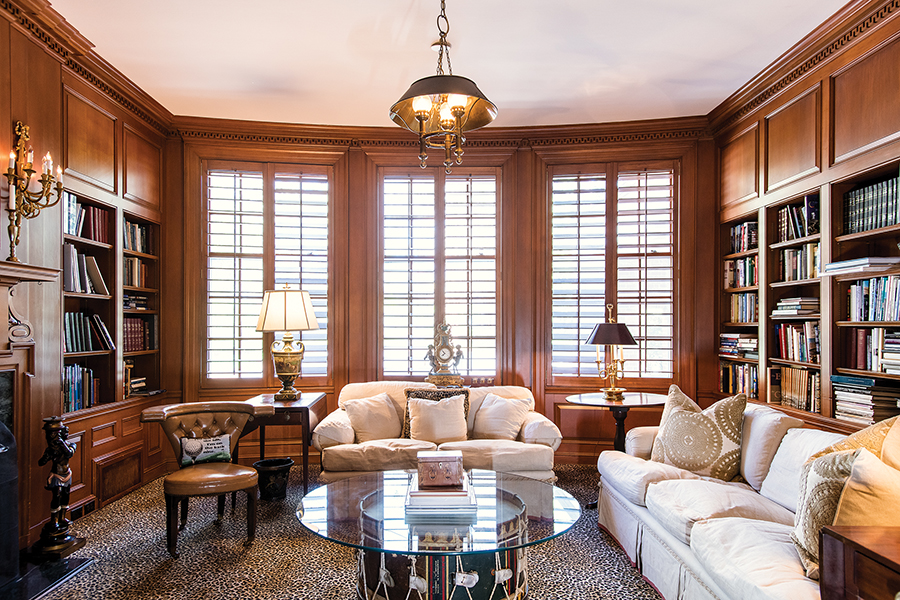
The son of Ceasar Cone — co-founder of the Proximity Manufacturing Company, Revolution Mills and White Oak Mills, among other textile holdings — Benjamin Cone was a friend of Love’s and one of the few people in Greensboro with enough money to buy his palatial estate.
Benjamin Jr., Cone’s son, said his father enjoyed teasing his pal, Love, about purchasing the house from his ex-wife, calling it “Love’s Labor Lost,” a cheeky allusion to William Shakespeare’s comedic play.
Born in New York, Benjamin Cone attended grade school and high school in Greensboro and graduated from UNC-Chapel Hill, where he was a classmate of writer Thomas Wolfe.
Following his service in the U.S. Navy in World War II, Cone resumed responsibilities in the family business as well as following a life of public and charitable service. He was elected to the Greensboro city council and later served as mayor. Over the years, he also provided leadership to various charitable organizations and Moses H. Cone Memorial Hospital.
Cone and his wife, Anne, lived in the Love house from 1941 until 1977.
Their big house was often aglow with activity.
During World War II, the Cones sometimes entertained troops who were stationed at Greensboro’s Overseas Replacement Depot. There were frequent parties for business and community leaders, political figures, and neighbors.
According to News & Record writer Meredith Barkley, Benjamin Jr. remembers as many as seven servants “keeping the house going.”
English stage, television and screen actor Sir Michael Redgrave visited the Cones many times. Redgrave met the couple during the war years in Virginia Beach, when Redgrave’s ship was being retrofitted at the Norfolk Naval Shipyard.
Nominated for an Academy Award in 1947 and knighted by the late Queen Elizabeth II in 1959, Redgrave was famously the father of sisters Vanessa and Lynn Redgrave, acclaimed stage and film stars themselves. Vanessa reportedly spent a Christmas at the Love house.
Tyrone Power, the star of swash-buckling films such as The Mark of Zorro and The Black Swan, was a WWII U.S. Marine Corps pilot and a frequent guest of the Cones.
When the Cones decided to sell the house in 1977, the buyer was the late Richard Love, one of Spencer’s sons.
Richard — a successful builder in the region for nearly 50 years — undertook a major exterior project at the house his father had built.
“He added brick walks in front and put up a brick wall along Country Club Drive, giving the home a more formal look,” writes Barkley.
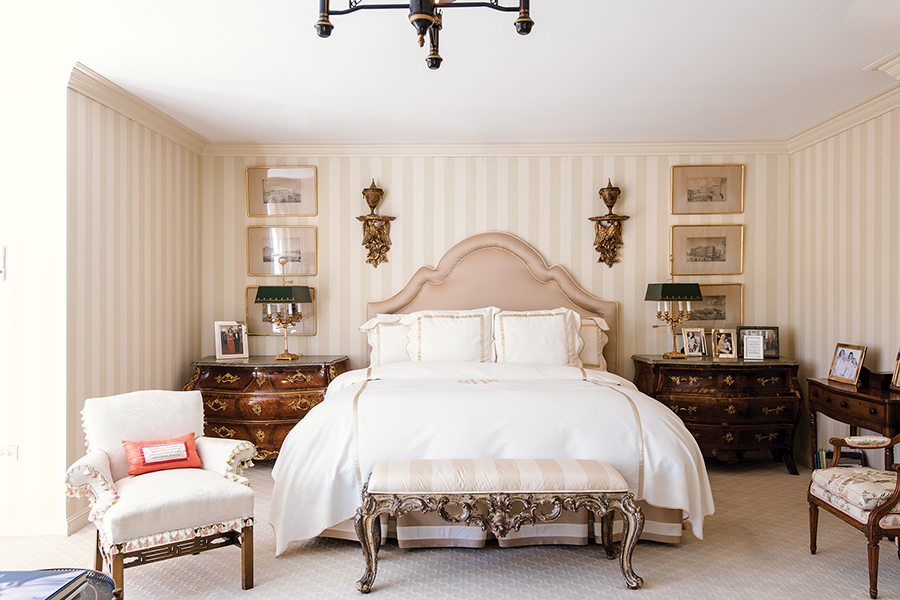
For his improvements, Love went back to the company his father had originally used — Old Virginia Brick Co. of Salem, Va. He ordered twice as many bricks as he thought he would need, culling out those he didn’t feel matched precisely, which were repurposed in other building projects.
In 1983 Love sold the property to the late John Russell “Rusty” Taylor Jr., a native of Battle Creek, Mich., who grew up in Greensboro. He was president of the first senior class to graduate from Walter Hines Page High School in 1961, attended Harvard University and received his law degree at UNC-Chapel Hill. He trained as a U.S. Marine Corps pilot during the Vietnam war and later joined his father’s real estate firm in Greensboro.
Taylor concentrated on updating the house’s electrical and mechanical systems, modernizing the telephone and security systems, repairing the leaky roof, and adding a workout facility and sauna in the basement. Taylor passed away suddenly in 1995.
And that brings us to the current owner.
Bonnie McElveen-Hunter and her husband, the late Bynum Merritt Hunter, moved into the Love house in 1997 with their son, Bynum Jr.
Bynum Hunter grew up in Fisher Park, attended Woodberry Forest School and served in the U.S. Navy in the Pacific during WWII. After military service, he was a star track athlete at UNC-Chapel Hill and received his law degree there. An admired courtroom attorney, he rose to become a senior partner with the firm of Smith Moore Smith Schell & Hunter in Greensboro and served as attorney for the Atlantic Coast Conference for more than 25 years.
Bonnie McElveen-Hunter was married to Hunter for 38 years. A businesswoman, philanthropist and diplomat, she was born in Columbia, S.C., the daughter of a U.S. Air Force P-51 pilot in WWII and a school teacher.
As a military kid, McElveen-Hunter moved with her parents as a toddler to Germany and later to Washington, Texas, Oklahoma, Louisiana, California and Nebraska.
She graduated from high school in Nebraska and attended Stephens College in Missouri.
After graduation, she moved to Charlotte to work for Bank of America and later as an advertising executive for Charlotte Magazine.
In 1972 McElveen-Hunter moved to Greensboro to work for Congressman Walter E. Johnston III and started Pace Magazine, the inflight publication of Piedmont Airlines. Adding magazines for United Airlines, Delta Air Lines, U.S. Airways, Southwestern Airlines and others, CEO McEveen-Hunter built her company into Pace Communications, a firm providing publishing services for travel, automotive, luxury, finance and technology clients. Pace Communications is now the largest independently owned custom content agency in the country.
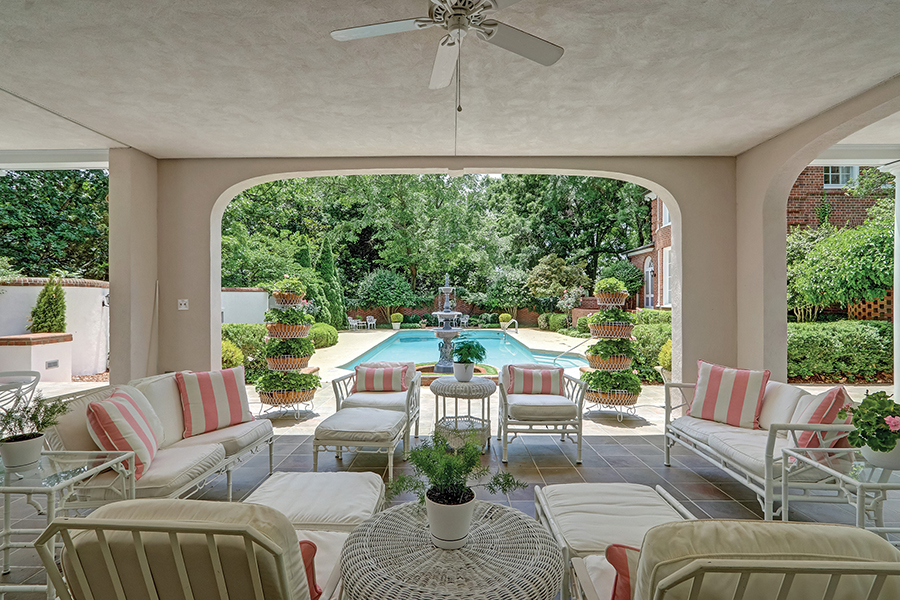
In 2001, McElveen-Hunter was appointed as ambassador to Finland by President George W. Bush and served until 2004, when she became the first female chairperson of the American Red Cross.
Surveying the extensive renovations undertaken by McIveen-Hunter in 1997, News & Record writer Barkley noted the dust, debris, exposed steel beams and general mayhem. She noted the soon-to-be master bedroom suite upstairs “looked like a bomb hit it.” Upstairs walls were moved for comfortable new bedrooms, walk-in closets, dressing areas and elegantly appointed his-and-her bathrooms.
Downstairs the kitchen was completely gutted and a fireplace, wet bar, handcrafted library shelves and custom cabinets, and hand-milled crown molding were installed in the Cone room. That carpentry work was done by Ren Putnam, a master woodworker and furniture maker in Reidsville with a degree from Duke Divinity School.
“What people don’t realize is that the Love house was built to industrial standards,” Putnam says, noting the use of masonry and concrete throughout.
“I think Spencer Love wanted to build a place that was nearly fireproof,” Putnam adds.
Masonry increased the difficulty of installing the custom wood cabinets. Even more difficult was the installation of the intricate, handmade crown molding throughout the Cone room, where the wall and windows overlooking the swimming pool are built on the curve.
“We had to use a jack to bend the molding into the curve,” says Putnam. “Then getting it fixed to that masonry wall? Now that was something.”
Later, in 2008, McElveen-Hunter decided to install a geothermal heating and cooling system at the Love house. She asked Putnam to supervise the project.
Installing a modern geothermal system in an old house built like a fortress was quite a challenge.
“The men dug 16 dry wells 400 feet deep,” Putnam says.
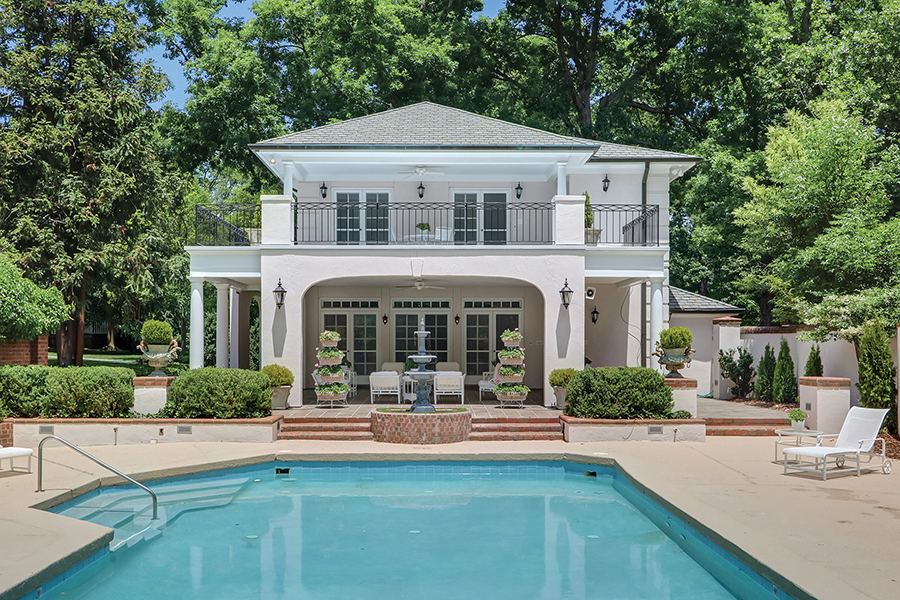
The drilling left deep piles of stone dust all over the property. Geothermal tubing was installed in the dry wells and run to the carriage house, pool house, cottage and main house.
“Then Bonnie decided she wanted a well for irrigation,” Putnam says. “So we asked this country boy to come in with his divining rods.” In a short while, the man marked a place toward the back of the property and told them to drill.
“Sure enough,” Putnam says, “we hit water at about 300 feet.”
The entire geothermal project took months to complete.
“I don’t know of anything like it around here,” Putnam adds.
And that’s the point of it.
Greensboro has never seen anything quite like the Love house, where — over the years — owners have lavished additions and updates that boggle the mind.
After my tour, I feel as if I’ve just been inside something important. And now that the home is for sale again, its future is uncertain.
I’m feeling disquiet. Could this magnificent historical home one day be torn down?
“Sadly,” says Briggs, “we’ve seen such things happen.”
I think about McElveen-Hunter’s answer about why she purchased the Love house 26 years ago. So I reach out to her.
When she calls me from her home in Palm Beach, I ask her why anyone would want to buy the house now?
“This place is more than a home,” she responds. “It’s relationships. Experiences. Memories. It belongs to the community.”
“I’ll never leave this house,” McElveen-Hunter concludes. “I’m just passing it on. I hope someone else will love it just as much as I do.”
Greensboro’s unique Love’s labor. May it never be lost. OH
Ross Howell Jr. is a contributing writer to O.Henry. He’s currently working on a novel about the 1935 Labor Day hurricane in Florida.
